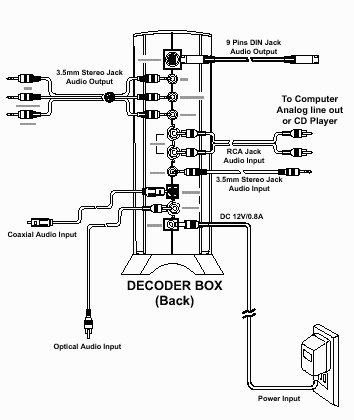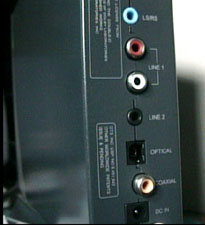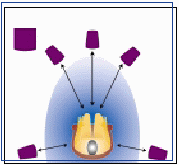Jazz Speaker Digital Audio Decoders
Introduction
When you think of home theater, Jazz Hipster isn’t the first name that pops into mind. That may soon change for the throngs of people who have heard the versatile little box perform. The Jazz DE – 006 and the DE-005 features Dolby Pro Logic, Dolby Digital & DTS decoding as well as several DSP ambience modes.


Before we go into more detail of the DE-006 and the DE-005 let me give you a small insight as to what Dolby Digital (AC3) and Dolby Pro Logic means. I know a lot of you might think you know the difference of each, however after conducting my own survey I came to the conclusion it’s best to write about it.
Dolby Pro Logic
In Dolby Pro Logic mode you’re offered 4 full range discrete channels for left, center and right speakers in the front of the listener, a single surround channel for two more speakers to the sides, and a low-frequency effects channel. All the amazing bass effects are carried through this effects channel. Dolby Pro Logic is capable of extracting surround information from encoded program material and also adds a center channel to keep dialogue and center effects firmly positioned in the center of your display area. All of you’re of course familiar with surround sound; Dolby Pro Logic is a more advanced version of it providing better channel separation and gives more accurate sonic perspectives than plain surround sound.
Dolby Digital (AC3)
Dolby Digital or AC3 and DTS (Digital Theatre Systems) are the most popular and most advanced forms of audio reproduction forms available today. A much-advanced version of Dolby Pro Logic it uses a form of digital audio coding specifically developed for recording and transmitting multi-channel surround sound. In contrast to Dolby Pro Logic’s 4 channels Dolby Digital provides up to 5.1 discrete sound channels, which includes separate full-range surround channels delivering true stereo surround effects for greater depth and realism. The 5.1 channels are Left, right, center, two separate left and right surround channels and a low-frequency effects channel. The .1 referred here is where the subwoofer connects.
Specifications and Installation
SPECIFICATIONS for both DE-006 and DE-005
| FUNCTIONS |
|
| AUDIO MODES |
|
| AUDIO INPUT |
|
| AUDIO OUTPUT |
|
| REMOTE CONTROL |
|
| DIMENSIONS (W x H x D) |
Decoder Box:75 x 180 x 230mm, 3.0″ x 7.1″ x 9.1″
Decoder Box:148x 42 x 200mm, 3.0″ x 7.1″ x 9.1″ |
Installation
DE-006
As you open up the packaging you’re offered the decoder box (Surprise 🙂 ), Power adapter, Remote control, two AAA batteries, Coaxial cable, 3.5 Stereo mini to RCA (R & L) connector and a user manual. If you’re somewhat an armature in the audio arena, then the supplied user manual will hardly be of any use. It’ll provide you with information as to what each function will do, but nothing comprehensive with regard to the installation. So I headed over to their web site and downloaded the .pdf manual available. While this too wasn’t very comprehensive it was certainly better than the latter. Here’s a small illustration on how everything fits in to the decoder box of the DE-006.

There are 3 main audio inputs which you could choose from, namely Line, Optical and Coaxial.

Here’s how I have worked this out. I have attached the optical input to my set top DVD player, and the Coaxial cable to my PC sound card. Make note that your sound card should have a Coaxial S/PDIF out in order to do this. It’s not necessary for you to connect all your devices into the system, however it makes everything much more convenient.
Then comes the configuration of the outputs.

As you can see right on top is a 9 Pin DIN Jack. If you plan on using this it must conform to Jazz Speaker’s standard DIN configuration. Have a look at their speaker products range at www.jazzspeakers.com and see if there’s anything that interests you. Don’t ever opt for a two-piece or three-piece speaker system if you ever want to get the full benefits of this decoder.
Next to the 9 pin DIN connector is the most noticeable green, yellow and blue stereo outputs. The green jack is where you connect the front left and right channels. The Yellow one is for the center channel and the subwoofer. The blue is for the left surround and right surround speakers. All speech and Bass is filtered out through the Center/Sub channel, and added surround sound effects are given through the left right surround channel. One more thing you should remember is that the signals produced by the DE-006 is not amplified, so you do have to amplify each channel in order to get good sound. If you’re using any Jazz Speaker system or any other PC speaker system this is not required as it has its own amplification. At the time I received the decoder from Jazz Speakers I didn’t have a good center channel. So in search I went around town testing speakers and settled for a “Mission” center channel for $250. I know it’s a pretty hefty price to pay, nevertheless if you’re an audio enthusiast like me then it’s well worth the price.
DE-005
If you had been following what I said above then their nothing more to say here other than simply follow the same instructions. Again here too the included manual is no great help, and the manual available in the web site is more detailed than the one available for the DE-006.
This is all there is to connecting all the wiring. Before we head on just remember the placement of your speakers is also very vital for good acoustics. The most common way of 5.1-speaker placement is shown in the illustration below. However let this be only a guideline, you should try out for your self various placements and see, which is best suited for your room acoustics.

i have this decoder but remot is missing of decoder. Humbly request to your suggestion how can i purchase that’s remot
Hi Ramesh,
Unfortunately it’s unlikely you’d be able to get the same remote, however your best bet here would be to see if you’d be able to use an universal remote and program the unit to work with the decoder.
Cheers